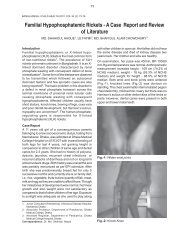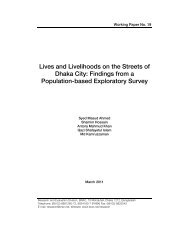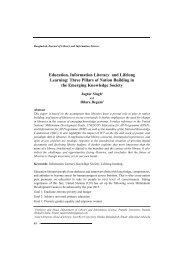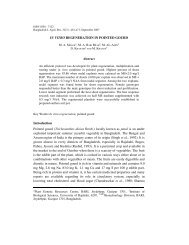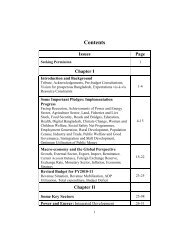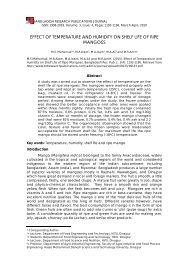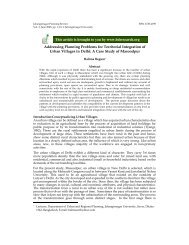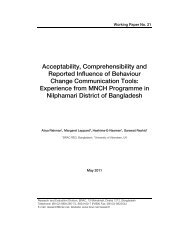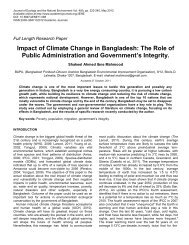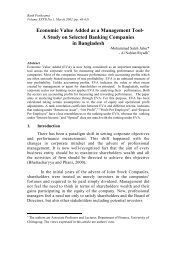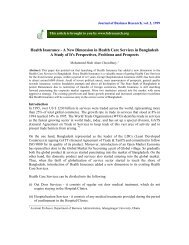Studies on Policy Option for Quality Seed Production and ... - NFPCSP
Studies on Policy Option for Quality Seed Production and ... - NFPCSP
Studies on Policy Option for Quality Seed Production and ... - NFPCSP
You also want an ePaper? Increase the reach of your titles
YUMPU automatically turns print PDFs into web optimized ePapers that Google loves.
4.2.20 <strong>Seed</strong> drying place of wheat as used by the farmersThe seed moisture c<strong>on</strong>tent can be used as an indicator <strong>for</strong> safe storage into the storage c<strong>on</strong>tainers. At allthe study sites, a li<strong>on</strong>’s part of the sample farmers (69%, 63% <strong>and</strong> 65% farmers in Rajshahi, Dinajpur<strong>and</strong> Rangpur, respectively) dried their wheat grain/seed <strong>on</strong> the ground ( katcha floor) which was notsufficient <strong>for</strong> reducing the seed moisture up to the st<strong>and</strong>ard level required <strong>for</strong> `safe storage’ i.e. within10-12% (Table 4.2.19). The percentage of farmers those who dried wheat seed <strong>on</strong> polythene sheet were23%, 18% <strong>and</strong> 24% in Rajshahi, Dinajpur <strong>and</strong> Rangpur, respectively. A fewer number of farmers usedplastic/cloth <strong>and</strong> cemented (pucca) floor (average of 10% <strong>and</strong> 3% farmers) <strong>for</strong> seed drying in the studyareas.Table 4.2.19 <strong>Seed</strong> drying place of wheat as used by the farmers at the study areasFarmers’ category%farmers drying seeds <strong>on</strong>Soil ground Pucca floor Polythene sheet Plastic/cloth TotalRajshahiLarge 61 3 24 12 100Medium 64 5 27 4 100Small 81 0 18 1 100Average 69 3 23 6 100CV (%) 10.6 10.7 16.7 17.1 -DinajpurLarge 64 5 23 8 100Medium 54 2 20 24 100Small 72 3 12 13 100Average 63 3 18 15 100CV (%) 11.4 9.7 12.4 19.1 -RangpurLarge 68 3 16 13 100Medium 58 5 31 6 100Small 69 0 26 5 100Average 65 3 24 8 100CV (%) 9.5 15.1 14.3 22.4 -Average (all sites) 66 3 22 10 1004.2.21 Producti<strong>on</strong> functi<strong>on</strong> <strong>for</strong> wheat seed/grainThe estimated producti<strong>on</strong> functi<strong>on</strong> presented in Table 4.2.20 reveals that the regressi<strong>on</strong> coefficients offarm size, rate of urea, number of irrigati<strong>on</strong>, number of human labor <strong>and</strong> seed classes significantlyinfluenced the grain/seed yield of wheat. The seed rate had negative effect <strong>on</strong> yield. Besides,applicati<strong>on</strong> of cowdung, TSP <strong>and</strong> MP had no significant effect <strong>on</strong> the grain yield of wheat.The earlier survey results presented in Chapter 4.2.18 showed that most of the farmers do not userecommended doses of fertilizers <strong>for</strong> wheat grain cultivati<strong>on</strong>. The use of urea was moderately bettercompared to the use of other fertilizers. Even in most cases they do not apply any cow dung or n<strong>on</strong>-ureafertilizers (like TSP, MP, gypsum etc.) in their wheat fields. Moreover, the farmers can not maintain themanure quality. They just keep the organic manure in the heap under open sunny place without havingany rain protecti<strong>on</strong> shade. There<strong>for</strong>e, most of the nutrients, especially the nitrogen c<strong>on</strong>tent, are leachedout with rainwater, which deteriorates the quality of the manure. This type of manure generally has63



